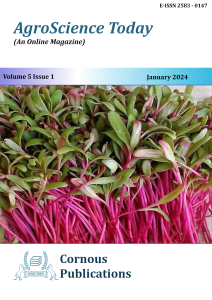Sugarcane based Integrated Farming system can improve the economics of sugarcane farmers and a way towards organic agriculture. Instead commercial Agriculture, Sustainable Agriculture can be adopted in the farmers field through Integrated Farming System. Sugarcane is a 12 months old crop and no part of cane is commercial except Sugar production. This Integrated Farming system includes the Farm pond with fishes Tilapia, grass crap, common crap for additional revenue and as rain water storage in both rainfeds and irrigated system of farming. Livestock, goat, honey bee, azolla, mushroom, vermicompost can be interlinked for effective recycling of resources. The output of one component should be the input of other component. All the crop residues will be converted to organic manure through vermicomposting and this manure is applied to the sugarcane, this in turn reduces the cost of fertilizers and improves the yield and soil fertility. Goat component is a remunerative enterprise in a ratio of 20+3 (female + male) per hectare.
The goat pellet can be manure for sugarcane and the weed problem will be reduced on goat grazing during land preparation. Milch animals is also integrated, detopped cane is now a very great fodder for cattle nearly 0.3mha of sugarcane area is available in Tamil Nadu, detopped cane can be green fodder meets the demand of livestock atleast for one month during harvesting. The inter cropping of blackgram, green gram, groundnut and sorghum can also meet the fodder demand of the cattle. Azolla is now turning in to livestock and fish feed hence, this also added as a component in sugarcane based intercropping system. Honey bee supplements the iron requirement of the family members and an additional income as this can be reared on borders of farmpond and can collect nectar form the seed crop of green manure or intercrops of blackgram or green gram. Flowchart is clearly depicts the flow and recycle of resources in sugarcane based farming system.
Microgreens are a stage between sprouts and fully grown greens, often known as Thalirkeerai in Tamil. About 4 to 40 times more nutrients are available in micro greens than their mature counterparts. Even picky eaters, especially kids, can enjoy them, offering a solution to malnutrition issues. Starting a microgreens business is affordable, with an initial investment of Rs. 5000 to 10000 only. Microgreens cultivation is ideal for women at home or students due to its low labor requirements. Seeds like fenugreek, mustard, sesame (black & white), wheat, barley, rye, green gram, black gram, horse gram, green and red amaranth, radish, cabbage, beetroot etc. can be used for micro greens purpose. Media used for cultivation of micro greens are potting mixture, coca peat, hydroponic, tissue paper etc.
Due to overpopulation in cities, excessive use of chemicals on crops poses health risks. To combat this, urban residents are turning to establish and maintain small home gardens, even utilizing limited spaces like balconies. Recognizing the significance of home gardens, people are exploring alternatives like terrace gardening and vertical gardening when space is scarce. A model vertical system namely Arka Vegetable Garden Structure for growing vegetables, flowers, and herbs in small urban spaces, was developed by Indian Institute of Horticultural Research located at Bengaluru.
Cocoa is multiplied by seeds. The seeds are separated from fruits. Cocoa fruits require 5-6 months from pollination to reach the maturity stage for harvest. The change of pod colour from green to yellow (Forastero) and red to yellow (Criollo) are the harvest indices of cocoa. The seeds are to be collected from biclonal or polyclonal seed gardens by utilizing elite self-incompatible parents is suggested to maintain genetic superiority of planting materials. In this article, the commercial propagation method of cocoa is well explained with selection of mother plant, selection of seed nut, seed extraction and nursery practices.
